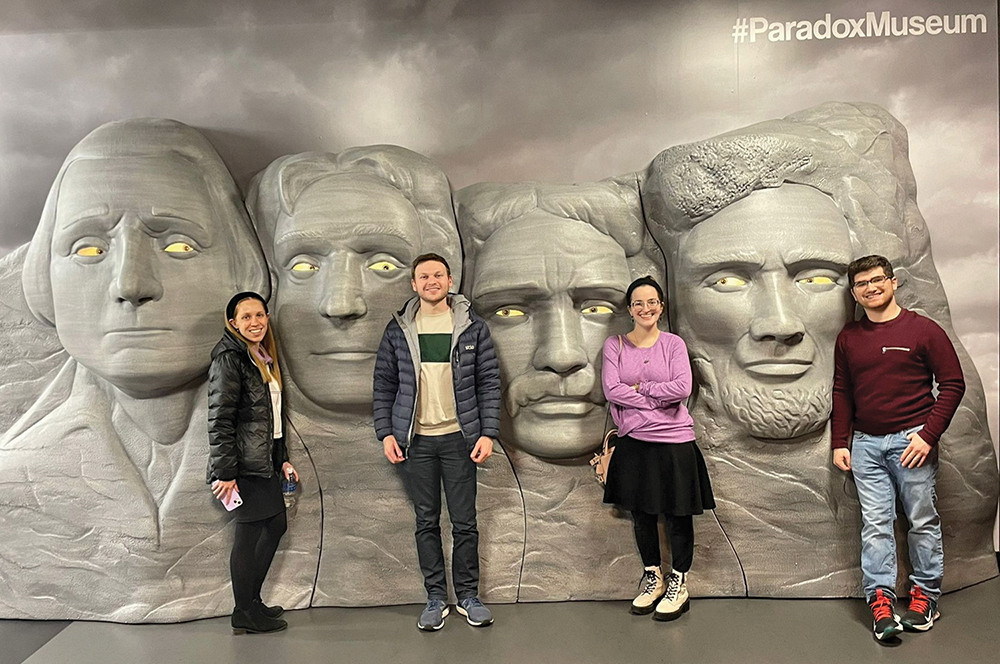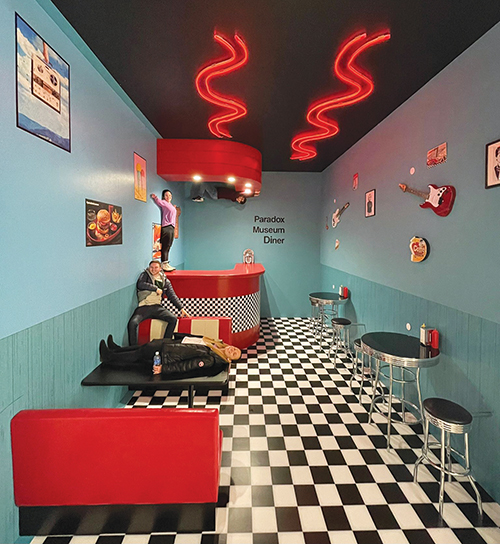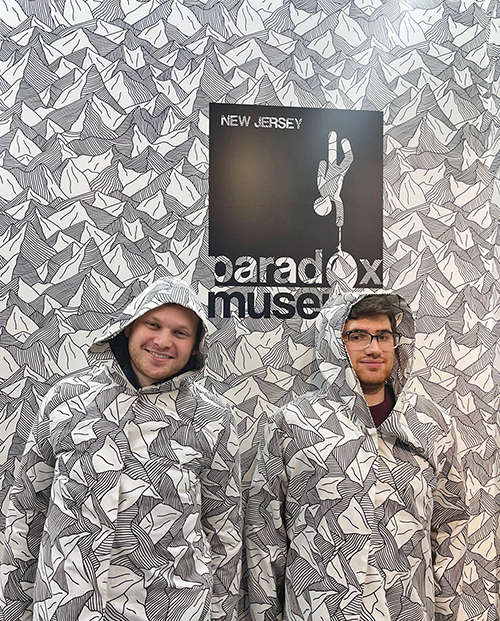
I would love to tell you about the American Dream Mall’s latest immersive exhibit, the Paradox Museum. My wife and I went there recently with our friends Zach and Lauren. It was a mind-boggling experience that left us confused about our own reality, but with a newfound appreciation for optical illusions.
The Paradox Museum is located on Court A, Level 1, next to other activities such as the Mirror Maze, Blacklight Mini Golf, Activate, Legoland Discovery Center and Sea Life Aquarium, making it a perfect fun hub for the family. We parked in Lot A to be as close as possible to the museum, and I highly recommend that whenever you’re going to the mall, park nearest to the stores or attractions you plan to visit.
After checking in, we entered the first room of the museum, bearing a sign on a wall stating the definition of a paradox—”a situation or statement that seems impossible or absurd, but in reality expresses a possible truth.” On the opposite wall, an introductory video explaining what would be happening during the exhibit was playing, but since the audio was pretty quiet, I couldn’t really hear it. From there, we headed to the next room where the “trippy” experience began.

In total, there are over 70 exhibits at the Paradox Museum, and we certainly felt the multitude while walking through its many different rooms, each one wackier than the last. It’s hard to precisely describe what happened in each room since I’m no expert on optical illusions, but nonetheless, I’ll share some of my favorites. One of the earlier exhibits was the Paradox Clock, a circle that appeared to be spinning, yet in reality, the circle itself remained still while only a small part of it (with a different background) was actually moving. The Shadow Freeze room had a green wall coated with phosphorus designed to absorb bright lights. So, we took turns pressing the camera button, which gave us a few seconds to strike a pose, and then a bright light flashed. Our poses were cast as shadows on the green phosphorus wall because that part of the wall didn’t absorb any light due to being blocked by our bodies, while the rest of the wall did. My favorite pose involved mimicking a fake stickup where my very own shadow appeared to threaten me while I pretended to shriek in terror.
Other rooms played eye tricks on us. One room had a bunch of portraits that looked like one image, such as a princess, but when rotated upside down, an old woman’s image appeared. Another exhibit featured a model of Mount Rushmore, with each of the president’s eyes seemingly following you no matter where you were standing. Many exhibits utilized mirrors to produce interesting effects. There was an infinity tunnel exhibit that gave the appearance of a tunnel of mirrors wrapped around the wall. An infinity dodecahedron, a 12-sided complex polyhedron, which when stared directly into, looked like a fall down a rabbit hole in “Alice in Wonderland.” Another exhibit was a “true” mirror that reflected your image in the same way others really see you versus how you see yourself in your own mirror. Farther on was a room entirely made up of mirrors, including the door, walls, ceilings and floor. So when closed in, you saw dozens of images of yourself staring back at you. The face blender exhibit contained a ladder of mirror rungs, in which two people stood on opposite sides of the ladder. The mirrors, reflecting pieces of each person, created a warped image of the two people. Ahuva’s favorite exhibit was a box surrounded by mirrors, creating the illusion of invisibility. Hidden behind the box was a hole allowing people to crawl through, popping their heads out the top, giving the appearance of a floating head detached from a body.

There were also exhibits that utilized technology, such as the musical AI piano. We would speak into a microphone, and the piano played back notes as if it were talking to us. Fortunately, there were also subtitles translating the piano’s communication. We could have the piano sing songs to us, count to 10, play tic-tac-toe, and so much more. A room with a bridge surrounded by a spinning red tunnel, reminiscent of a scene from “2001: A Space Odyssey,” stands out for our difficulty in walking across the bridge since the room appeared to be spinning, completely throwing off everyone’s balance. For some of the final rooms, like the TiLT Museum, opportunities for unique photo perspectives abounded. One such room was the Paradox Museum Diner, laid out in a way that when the photo is rotated, everyone in the photo appeared to be in impossibly bizarre poses. For example, I did a pull-up on a table attached to the wall, and in the final photo, it looked like I was Spider-Man hanging onto the ceiling!
All in all, we went through the Paradox Museum in around an hour and a half. If you take your time, however, and really read through each plaque explaining how each exhibit is possible, it could certainly take closer to two hours. In this article, I mentioned many of the illusions that stood out to me, but this is only a fraction of what the museum offers. Truthfully, you have to see it to believe it.

The Paradox Museum was certainly worth the price of admission, and I highly recommend checking it out. It was laid out so well, with each room blowing our minds in a different way every time. Make sure to dress for pictures because this is an experience you’ll want to capture with some keepsake photos to take home with you!
Admission: Adults ($25), Children ($20), discounted rates for New Jersey residents, military (from $22), and group rates (starting at $20 for 10-20 people)
Hours: Sun 11am-7pm, Mon-Thurs extended to 8pm, Fri-Sat extended to 9pm
Located: Court A, Level 1


Zachary Greenberg is a consultant at Semler Brossy and the TABC track coach. To kick off New Year’s in 2020, Zachary ran the NYRR Midnight Run in Central Park. He also recently watched the film “Wonka” in theaters. If you have any recommendations of fun places for him to cover, email zachary@jewishlink.news.









